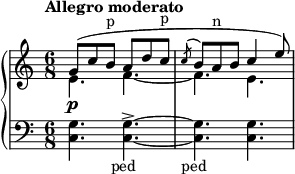
Back Nota estranya Catalan Nebenton German Akordiväline heli Estonian نتهای زینت Persian Note étrangère French 非和声音 Japanese Неаккордовые звуки Russian 和弦外音 Chinese

A nonchord tone (NCT), nonharmonic tone, or embellishing tone is a note in a piece of music or song that is not part of the implied or expressed chord set out by the harmonic framework. In contrast, a chord tone is a note that is a part of the functional chord. Nonchord tones are most often discussed in the context of the common practice period of classical music, but the term can also be used in the analysis of other types of tonal music, such as Western popular music.
Nonchord tones are often categorized as accented non-chord tones and unaccented non-chord tones depending on whether the dissonance occurs on an accented or unaccented beat (or part of a beat).
Over time, some musical styles assimilated chord types outside of the common-practice style. In these chords, tones that might normally be considered nonchord tones are viewed as chord tones, such as the seventh of a minor seventh chord. For example, in 1940s-era bebop jazz, an F♯ played with a C 7 chord would be considered a chord tone if the chord were analyzed as C7(♯11). In European classical music, "[t]he greater use of dissonance from period to period as a result of the dialectic of linear/vertical forces led to gradual normalization of ninth, eleventh, and thirteenth chords [in analysis and theory]; each additional non-chord tone above the foundational triad became frozen into the chordal mass."[2]
- ^ Kostka & Payne (2004), p. 189.
- ^ "Debussy and the Crisis of Tonality", p. 72. Author(s): Roland Nadeau. Music Educators Journal, vol. 66, no. 1, (September 1979), pp. 69–73. Published by: MENC: The National Association for Music Education.